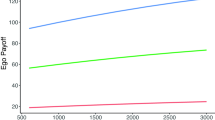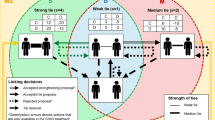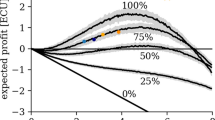Abstract
We investigate the effects of centrality on cooperation in groups. Players with centrality keep a group together by having a pivotal position in a network. In some of our experimental treatments, players can vote to exclude others and prevent them from further participation in the group. We find that, in the presence of exclusion, central players contribute significantly less than others, and that this is tolerated by those others. Because of this tolerance, groups with centrality manage to maintain high levels of cooperation.





Similar content being viewed by others
Notes
It is important to note that exclusion is not the only mechanism that might affect the structure of a network. Many networks, for example, form endogenously with members joining and leaving at their own discretion. Endogenous group formation has been shown to positively affect contributions in experimental public goods environments (e.g., Ehrhart and Keser 1999; Coricelli et al. 2004; Page et al. 2005; Gunnthorsdottir et al. 2007; Ahn et al. 2008). The changes in network structure that arise from this endogeneity, however, will typically not affect players’ centrality; the networks in such experiments are designed to be complete, with every pair of members being directly linked. In contrast, our experimental networks either have one central player or have none. This provides control over the centrality and allows for clean inferences on the effects of centrality on contributions.
We also conducted an additional set of treatments where the central player decides on the allocation of the surplus created in the VCM games. For more details, see van Leeuwen et al. (2015).
We allow players the option to vote to exclude themselves as well. This was observed in only 6 out of 3203 instances of voting.
We discuss here the situation after the first exclusion. This is presented in Fig. 1. The cases for subsequent exclusions follow straightforwardly.
Summaries of the experimental instructions are provided in Appendix A in ESM. Full instructions and the test questions are provided in Appendix D in ESM.
In some settings, costless voting could lead to repeated game equilibria with positive contributions (Hirshleifer and Rasmusen 1989). However, in our study, excluded players still earn their endowment (which equals the Nash stage-game payoff). For this reason, there exists no subgame perfect equilibrium with positive contributions if all agents are self-interested.
In Table C.2 in Appendix C in ESM, we also report p values based on Mann–Whitney and Wilcoxon signed-ranks tests.
References
Ahn, T. K., Isaac, M., & Salmon, T. C. (2008). Endogenous group formation. Journal of Public Economic Theory, 10(2), 171–194.
Anderson, L. R., Mellor, J. M., & Milyo, J. (2008). Inequality and public good provision: An experimental analysis. The Journal of Socio-Economics, 37(3), 1010–1028.
Bénabou, R., & Tirole, J. (2006). Incentives and prosocial behavior. American Economic Review, 96(5), 1652–1678.
Buckley, E., & Croson, R. (2006). Income and wealth heterogeneity in the voluntary provision of linear public goods. Journal of Public Economics, 90(4–5), 935–955.
Burt, R. S. (1992). Structural holes: The social structure of competition. Cambridge: Harvard University Press.
Carpenter, J., Kariv, S., & Schotter, A. (2012). Network architecture, cooperation and punishment in public good experiments. Review of Economic Design, 16, 93–118.
Chan, K. S., Mestelman, S., Moir, R., & Muller, R. A. (1999). Heterogeneity and the voluntary provision of public goods. Experimental Economics, 2(1), 5–30.
Charness, G., Feri, F., Meléndez-Jiménez, M. A., & Sutter, M. (2014). Experimental games on networks: underpinnings of behavior and equilibrium selection. Econometrica, 82(5), 1615–1670.
Charness, G., & Yang, C.-L. (2014). Starting small toward voluntary formation of efficient large groups in public good provisions. Journal of Economic Behavior & Organization, 102, 119–132.
Cherry, T. L., Kroll, S., & Shogren, J. F. (2005). The impact of endowment heterogeneity and origin on public good contributions: evidence from the lab. Journal of Economic Behavior & Organization, 57(3), 357–365.
Cinyabuguma, M., Page, T., & Putterman, L. (2005). Cooperation under the threat of expulsion in a public goods experiment. Journal of Public Economics, 89, 1421–1435.
Coricelli, G., Fehr, D., & Fellner, G. (2004). Partner selection in public good experiments. Journal of Conflict Resolution, 48(3), 356–378.
Cornes, R., & Sandler, T. (1996). The theory of externalities, public goods, and club goods. Cambridge: Cambridge University Press.
Cross, R., & Prusak, L. (2002). The people who make organizations go—Or stop. Cambridge: Harvard Business Review.
Dekel, S., Fischer, S., & Zultan, R. (2017). Potential pareto public goods. Journal of Public Economics, 146(C), 87–96.
Eckel, C., Fatas, E., & Wilson, R. (2010). Cooperation and status in organizations. Journal of Public Economic Theory, 12(4), 737–762.
Ehrhart, K-M., & Keser, C. (1999). Mobility and cooperation: On the run. CIRANO Working Papers, 99s-24, CIRANO.
Fatas, E., Meléndez-Jiménez, M. A., & Solaz, H. (2010). An experimental analysis of team production in networks. Experimental Economics, 13, 399–411.
Fehr, E., & Gächter, S. (2000). Cooperation and punishment in public goods experiments. American Economic Review, 90(4), 980–994.
Fischbacher, U., Schudy, S., & Teyssier, S. (2014). Heterogeneous reactions to heterogeneity in returns from public goods. Social Choice and Welfare, 43(1), 195–217.
Fisher, J. R., Isaac, R. M., Schatzberg, J. W., & Walker, J. M. (1995). Heterogenous demand for public goods: Behavior in the voluntary contributions mechanism. Public Choice, 85(3/4), 249–266.
Gangadharan, L., Nikiforakis, N., & Villeval, M. C. (2017). Normative conflict and the limits of self-governance in heterogeneous populations. European Economic Review, 100, 143–156.
Gërxhani, K., Brandts, J., & Schram, A. (2013). The emergence of employer information networks in an experimental labor market. Social Networks, 35, 541–560.
Goyal, S., & Vega-Redondo, F. (2007). Structural holes in social networks. Journal of Economic Theory, 137(1), 460–492.
Gunnthorsdottir, A., Houser, D., & McCabe, K. (2007). Disposition, history and contributions in public goods experiments. Journal of Economic Behavior & Organization, 62(2), 304–315.
Hargreaves Heap, S. P., Ramalingam, A., & Stoddard, B. V. (2016). Endowment inequality in public goods games: A re-examination. Economics Letters, 146, 4–7.
Hirshleifer, D., & Rasmusen, E. (1989). Cooperation in a repeated prisoners’ dilemma with ostracism. Journal of Economic Behavior & Organization, 12, 87–106.
Isaac, R. M., & Walker, J. M. (1988). Group size effects in public goods provision: The voluntary contributions mechanism. Quarterly Journal of Economics, 103, 179–199.
Kreps, D. M., Milgrom, P., Roberts, J., & Wilson, R. (1982). Rational cooperation in the finitely repeated prisoners’ dilemma. Journal of Economic Theory, 27(2), 245–252.
Leibbrandt, A., Ramalingam, A., Sääksvuori, L., & Walker, J. M. (2015). Incomplete punishment networks in public good games: Experimental evidence. Experimental Economics, 18(1), 15–37.
Moir, R. (1998). A Monte Carlo analysis of the Fisher randomization technique: reviving randomization for experimental economists. Experimental Economics, 1(1), 87–100.
Nikiforakis, N., Noussair, C. N., & Wilkening, T. (2012). Normative conflict and feuds: The limits of self-enforcement. Journal of Public Economics, 96(9–10), 797–807.
Noussair, C., & Tan, F. (2011). Voting on punishment systems within a heterogeneous group. Journal of Public Economic Theory, 13(5), 661–693.
Page, T., Putterman, L., & Unel, B. (2005). Voluntary association in public goods experiments: Reciprocity, mimicry and efficiency. The Economic Journal, 115, 1032–1053.
Reuben, E., & Riedl, A. (2013). Enforcement of contribution norms in public good games with heterogeneous populations. Games and Economic Behavior, 77(1), 122–137.
Rosenkranz, S., & Weitzel, U. (2012). Network structure and strategic investments: An experimental analysis. Games and Economic Behavior, 75(2), 898–920.
Schram, A., Brandts, J., & Gërxhani, K. (2018). Social-status ranking: A hidden channel to gender inequality under competition. Experimental Economics. https://doi.org/10.1007/s10683-018-9563-6.
Tan, F. (2008). Punishment in a linear public good game with productivity heterogeneity. De Economist, 156(3), 269–293.
van Leeuwen, B., Ramalingam, A., Rojo Arjona, D., and Schram, A. (2015). Authority and centrality: Power and cooperation in social dilemma networks. SSRN working papers. (https://papers.ssrn.com/sol3/papers.cfm?abstract_id=2573348). Accessed 18 Sept 2018.
Weng, Q., & Carlsson, F. (2015). Cooperation in teams: The role of identity, punishment, and endowment distribution. Journal of Public Economics, 126, 25–38.
Acknowledgements
For useful comments and suggestions, the authors would like to thank the editor of this journal (Lata Gangadharan) and two anonymous referees, as well as Jordi Brandts, Antonio Cabrales, Jeff Carpenter, Ron Harstad, Eline van der Heijden, Andreas Leibbrandt, Jeroen van de Ven and participants at seminars at University of Massachusetts, UC Riverside, UC Irvine, University of Pennsylvania (SAS), University of East Anglia, ESI Chapman University, University of Málaga, University of Alicante, Jadavpur University, MPI Bonn, Indiana University and Utah State University, and participants at the workshop on Power, Games, and Fairness (Turku 2013), the 2013 ESA North American meetings in Tucson, the 2013 Southern Economic Association meeting, the 2014 Incentives and Behavior Change Workshop at the University of Amsterdam, the 2014 CCC-meeting at the University of Nottingham, the 2015 IMEBESS conference at the IAST, the 2016 BiNoMa Networks Meeting in Norwich and the 2016 Networks Workshop at Queen Mary London. Part of this paper was written while Arthur Schram was visiting the Institute of Economic Analysis (CSIC-IAE) in Barcelona. He thanks the IAE for their hospitality. Financial support from the Research Priority Area Behavioral Economics of the University of Amsterdam, the University of East Anglia, Chapman University and the ANR - Labex IAST is gratefully acknowledged.
Author information
Authors and Affiliations
Corresponding author
Electronic supplementary material
Below is the link to the electronic supplementary material.
Rights and permissions
About this article
Cite this article
van Leeuwen, B., Ramalingam, A., Rojo Arjona, D. et al. Centrality and cooperation in networks. Exp Econ 22, 178–196 (2019). https://doi.org/10.1007/s10683-018-9592-1
Received:
Revised:
Accepted:
Published:
Issue Date:
DOI: https://doi.org/10.1007/s10683-018-9592-1




